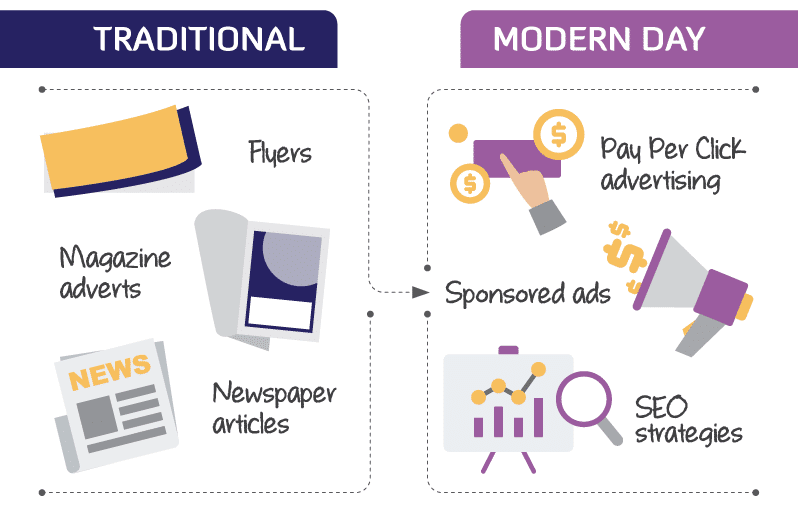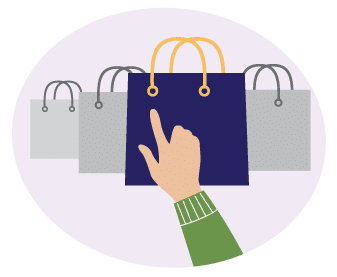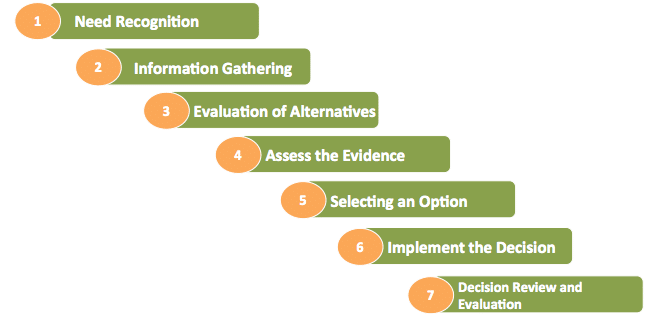In this article, we look at the consumer decision making model for the B2B market. The consumer decision making process model is very different in the B2B sector when compared to the B2C one as it is considerably more complex with a number of employees often being involved, each with their specialism in a differing field.
Contents
- Consumer Decision Making Process Infographic
- Stage 1: Need Recognition
- Stage 2: Information Gathering
- Stage 3: Evaluation of Alternatives
- Stage 4: Assess the Evidence
- Stage 5: Selecting an Option
- Stage 6: Implement the Decision
- Stage 7: Decision Review and Evaluation
- Consumer Decision Making Process – Summary
- What Is The Recommended Time Frame For Taking Action In The Decision Process?
- B2B Decision Making Examples
Over the last decade, there have been some major changes in the B2B consumer decision making process. With the arrival of the internet, marketers now have a more difficult job on their hands. The purchasing path today isn’t linear any more.
B2B buyers are now reading reviews and getting more information before choosing a product, and this is why traditional strategies for marketing are just not effective any more. Cold sales calls rarely receive a response, so the best way to attract B2B customers is to find an engaging way for retailers to put themselves in the place that their target audience will be searching for them.
The needs of B2B decision makers are more complex since they have to be accountable for every judgment. While consumers have rational and emotional needs at the personal level, B2B buyers not only have both of these needs types, they have them at a company level as well as a personal one.
In this article, we will give you the advice you need about the B2B consumer decision making process so you can have a better understanding which decision makers you should be targeting, and which needs you need to fulfil if you are to successfully sell your service or product. The infographic below looks more closely at the seven stages that every B2B buying team goes through when choosing a high involvement product for their company so you can have a greater insight into how to market your product more effectively.
7 Stages of The Consumer Decision Making Process:
Stage 1: Need Recognition

The very first step, and indeed, often the most important one, in the consumer decision making process is need recognition. No purchase can happen unless the consumer recognises that they have a need for your service or product. That need could be triggered by either external or internal stimuli, but whichever it is, the customer needs to be given a reason to think that they want or need something which they don’t already have.
The key for marketers and retailers is to make the customer recognise they have a problem which only they can solve. Once the consumer has gone through the phase of problem recognition, they can then embark on the purchasing process.
At one time, this was done through paper advertisements, cold calls or flyering. It was an effective way of putting an exciting new service or product under the nose of businesses which currently lacked anything similar. It was creating a problem for that consumer – and often a problem that they had never realised they had before. Once the consumer realised that there was something lacking which their business could benefit from and which they could easily get hold of, they could then make steps towards buying it. Today, the arena for this has mostly moved online, with effective content marketing and online strategies taking the place of physical marketing. Nevertheless, the end result should be the same.
It’s important, however, to realise that not all types of need recognition are the same. For example, if a company recognises that it has run out of printer ink, it can simply reorder it. It will probably do this from the same supplier that it always uses and this may even take place automatically, thus eliminating the need/problem recognition element from the consumer decision making process completely.
When it comes to high value items, however, the problem/need recognition element is still very much in evidence. Let’s take a look at how this might work:
A small scale delivery company decides that it’s time to replace its fleet of vans. This is a major outlay for the organisation. Several people in the company get together to discuss what they are looking for in their new van fleet. They finally go online to get more information about what type of vans they should be buying. They find the website of a local company which specialises in supplying fleet delivery vans at the top of the Google search engine rankings. They discover that this company offers a bundled package with insurance added on. The delivery company had never thought about this before but now decide that this could be the right way forward for their company. They call the fleet delivery van company and begin the purchasing process.
What key conclusions can we draw from this?
- To successfully attract consumers, a company must create a problem which their product or service can solve.
- They need to put their product or service before their target audience so they can see it.
- The consumer must recognise their need or desire for the service or product on offer.
- They will then go about embarking on the purchasing process.
Stage 2 – Information Gathering

The second stage of the buying process is information gathering. What is information gathering you may ask.
Once a consumer has recognised their problem or need, the information gathering process can begin. The buyer has acknowledged the issue and now they want to find a suitable solution. It’s as simple as that.
Information Gathering Techniques
There are several information gathering techniques which can be employed by consumers who want to find a solution to the problem that they have now acknowledged. Over the last few years, there has been a change in these techniques as technology has come more to the fore.
In the past, consumers relied heavily on physical sources for information that would help them to make their buying decision. This may have been in the form of:
- Flyers
- Magazine adverts
- Newspaper articles
- Word of mouth
- Billboards
- TV and radio ads
In 2019, while these forms of marketing still exist, they are no longer the primary way for marketers to establish their brand as a leader within their industry. There are now more effective online methods which can be harnessed to reach the target audience.
Online media has become increasingly popular among marketers and retailers as a businesses turn to the internet to find product information that can help them to make a final purchasing decision. The channels now being used include:
- Pay Per Click advertising
- Sponsored ads
- SEO strategies
- Social media marketing strategies
- Authoritative blog posts
- High quality websites
- Testimonials on review sites
As we move forward into 2019, brands are starting to look at other effective ways to establish their presence within their industry. They are now becoming Google Trusted Stores, which allow them to increase their search rankings while boosting the customer’s sense of security. This is a trend which looks set to continue and develop over the coming year.
 What key conclusions can we draw from this?
What key conclusions can we draw from this?
- When businesses recognise they have a need which needs to be fulfilled, they begin to gather information to help them make a purchasing decision.
- They may look at physical media like adverts, flyers or articles.
- Alternatively, and increasingly, they will turn to the internet to find relevant information.
Companies are now using a range of strategies to reach business consumers who are keen to buy their products including becoming Google Trusted Stores.
Stage 3 – Evaluation of Alternatives

Even when your product stands out from the crowd, that doesn’t necessarily mean that your business customers will definitely choose your service or product. Research is more important to consumers than ever before, and they will put lots of time into considering all their options before making a final purchasing choice.
This evaluation of alternatives means that they will be comparing a range of options just to make sure that they’ve made the right decision.
Over the last decade or so, this process has changed dramatically. Not so long ago, it was difficult to get information about different products and services. Buyers had to physically go to different stores or suppliers and make enquiries, or make repeated telephone calls.
As it was more difficult to compare prices and value, it was easier for the first business that the buyer found to make a sale. Today, this is far from the case. With the power of the internet, it’s the work of minutes to go online and compare the prices and services from different suppliers or providers.
As we move through 2019, these online evaluations are only going to increase. 67% of the buyer’s purchasing decision journey was made digitally over the last few years and up to 90% of B2B buyers use online search in their research process.

For marketers, it’s vital to continue to target the consumer. It isn’t enough to come to the attention of the buyer, it’s important to stay their target of focus.
One way to do this is to evaluate alternatives on your company’s own website. Have a live price comparison between your own products and services and those of your competitors right there on your own home page.
This is still important even if your competition offers a lower price. It simplifies the evaluation process for your potential customers, establishes your company as a reliable and trustworthy one, and hopefully discourages consumers from clicking away from your website before you’ve made a sale.
What are the key conclusions we can make from this?
- Consumers today won’t buy without evaluating the different alternatives to resolve their problem.
- They look for information about the value and price of the services they want from several suppliers.
- When they’ve compared all the information, they can evaluate it effectively and choose the right product or service provider for them.
- Marketers can take advantage of this by offering live price comparisons.
Stage 4 – Assess The Evidence

Once buyers have evaluated all their options, they can then move onto the stage of assessing the evidence that they have gathered. What does this involve? In short, it means that the buyer looks at the information about the products or services which they desire from all of the potential suppliers or providers and determine which is the right one for them.
This element is about more than just price in most cases. Often, a B2B buyer will choose a product which costs a little more than its rivals but which offers better value, better customer service or which has better reviews. This is therefore another area where marketers need to make their brand stand out from its rivals.
Over the last decade, the process used to assess the evidence has changed considerably. Ten years ago, assessing the evidence was a lot harder, especially when it came to reviews and testimonials. Finding out information about just how good a particular product or service provider was meant finding and then contacting previous customers, or trawling through publications to find reviews in printed format. Today, it is the work of moments to go online and check testimonials and reviews sites and to make a decision based on what is found there.
In 2019, review sites are set to be just as important for the assessing the evidence stage as ever. Marketers are now recognising this, and are working hard to respond to customer problems and comments so they can avoid negative reviews.
By responding appropriately and in a timely manner, it’s often possible to stave off bad reports that could deter future customers from making a purchase.
What are the key conclusions we can make from this?
- Customers need to assess the evidence that they have gathered from the information gathering process.
- This involves determining which is the right product or service for them depending on the value and quality that they will get from each.
- Testimonials and reviews are an important part of this process.
- Today, these are found quickly and easily online.
- For this reason, companies are working harder to engage with customers to prevent negative reviews.
Stage 5 – Selecting An Option

It comes as a surprise to many retailers that the process of selecting an option actually comes so late in the day. By this stage, the customer will have explored many different options.
They will have come to an understanding about the payment options and pricing and will know exactly what they will be getting for their money. They will have weighed up the pros and cons and will have determined which of the products and services is going to best meet the need that they have identified in their company. They will have read reviews and testimonials and chosen the supplier or service provider which is going to be most reliable and trustworthy.
Yet right up to this point, they could still have decided to forget all about the purchase. When they reach stage five, they finally reach the point where they make a final purchasing decision about which product or service they are going to select. This is a key moment for both purchasers and retailers alike.
Over the last decade, there have been changes even to this stage in the decision making process. In the past, high importance purchasing decisions tended to be left to the executive level of a company. When the managers or directors decided that they had found the perfect product or service to suit their business’ needs, the decision became final.

Today, however, there has been a significant change towards including members of staff further down the career ladder in the decision making process. Recent figures have shown that 81% of people making B2B purchasing decisions are below the executive level. That means that retailers who are aiming all their marketing at the upper echelons of companies are missing their target. There are also now many more people involved in making purchasing decisions at the high involvement level.
Today, in a company with between 100 and 500 staff members, there are usually seven people involved in the purchasing decisions. It’s no wonder, then, that in 2018 the sales process takes over 20% longer than it did just five years ago. Marketers need to be prepared for this and stay on target right to the end, keeping potential customers interested right up to the moment they make the purchase. 68% of B2B sales are lost due to perceived indifference, so retailers need to show their enthusiasm to make the same right up to the very last second.
What key conclusions can we make from this?
- Today the process of making a purchasing decision takes 22% longer than it did just 5 years ago.
- An average of 7 people are involved in the decision making process.
- 81% of those people are below executive level.
- The decision making team need to take into account the value and quality of the product or service being offered as well as the trustworthiness of the supplier or provider before choosing.
- Marketers need to stay on target right through to the conclusion of the sale. Perceived apathy leads to lost B2B sales.
Stage 6 – Implement The Decision

This stage is the one that retailers and marketers have been waiting for – the moment when the customer finally purchases the product or service. Every stage which has led up to this conversion has now been completed. In this past, this stage usually went without a hitch. The customer would call the company or go into the store, put down their money and receive their product or service.
In 2019, even at this point, things could go wrong and the sale could be lost. Marketing remains vital at this step of the proceedings too. Retailers need to be certain that the buying process is simple and straightforward.
Can the purchase be made online? Is the loading time fast enough? Are there a lot of steps which could put the purchaser off? Is the purchase process too complicated? Is it possible to buy on mobile devices? Making sure that your brand passes these tests is key to a successful sale.
Implementing the decision is further complicated these days by having so many people involved in the process, at different hierarchy levels. It’s no wonder that the sales process takes so long as disagreements and confusion are bound to ensue. It’s therefore important as we move forward towards the end of the decade to make sure that the purchasing process is smooth and convenient to minimise these problems.
What are the key conclusions we can make?
- The implementation of the decision stage still has potential for failure of the sale.
- With so many hierarchies and people involved in the purchasing decision there can be delays and confusion.
- Even at this point, a complex purchasing process can put off the buyer and cause them to abandon the sale.
- Retailers need to make the process simple and smooth, with a fully functional website.
Stage 7 – Decision Review And Evaluation

Finally, you retailers and marketers can take a deep breath as the sale is finally complete. Yet there is still a final stage to go – the post-purchase evaluation. At this stage, the marketer needs to look at the sale and the purchasing decision which the B2B consumer made to evaluate what went well and what could be changed in the future to make the process even smoother and more efficient.
This stage is still very important to the selling process as it is key to retaining customers, encouraging return business and further sales through word of mouth. When customers are happy with the service you provide, brand loyalty will follow and this will allow the information gathering and evaluation stage to be eliminated from the equation, speeding up the purchasing decision making process exponentially.
Monitoring therefore needs to take place at this point. Customers will often feedback either negative or positive comments and companies need to keep track of their social media profiles, website and review sites to make sure that they address any concerns and mitigate any damage caused by negative reviews.
Staying in contact with customers following their purchase through follow-up emails and surveys will help to reinforce the brand with the customer and give a positive impression which could well result in future sales.
Marketers are increasingly using analytics to check out and evaluate their sales process. As we move through 2019, these tools are going to prove even more beneficial as marketing teams can check data on site traffic, the number of repeat visitors, sales and productivity information and a host of other vital statistics which can inform future marketing strategies and the way in which the purchase process is handled to make it smoother, more efficient and more effective all round.
What are the key conclusions we can make?
- Once the sale is made, post-sale evaluation must take place to find out what went well and what needs to be improved next time.
- Retailers need to check whether their product satisfied their customer.
- They need to monitor feedback and mitigate any damage.
- They also stay in touch with customers to maintain a positive impression.
- Monitoring statistics is vital to assess which elements of the marketing strategy work well and where changes to the purchasing process need to be made.
- The goal is to encourage repeat business to eliminate the information gathering and evaluation phases.
Consumer Decision Making Process – Summary
In conclusion, here is a brief overview of the 7 stages of product purchasing decision making for B2B sales.
Stage 1 – Recognising the need or problem: Helping companies to recognise that they have a problem and that they need to find a solution i.e. your brand’s product or service.
Stage 2 – Information gathering: Companies will look for information about suitable products or services to meet the need they have identified. At this stage marketers need to put their own brand where the buyer can find it.
Stage 3 – Evaluation of alternatives: Companies will compare the information that they have gathered from different suppliers and providers to see which is the best one for them. Marketers must ensure that their product stands out for all the right reasons.
Stage 4 – Assess the evidence: Companies will assess the evidence that they have gathered and compared. They will find evidence to back up their opinions about which provider or supplier is best through searching for testimonials and reviews. Marketers must ensure that they stay engaged with former customers to ensure that their reviews are positive.
Stage 5 – Selecting an option: The company will decide which is the right supplier or provider to meet the need that they have identified. This can be a long and drawn out process because of the number of people on board. This means that marketers must keep their product at the forefront of the buyers’ minds.
Stage 6 – Implementing the decision: The buyer finally makes the step of purchasing the product or service. The marketer must make sure that their purchasing process is simple to avoid losing the sale.
Stage 7 – Decision review and evaluation: Once the sale has been made, the marketer must follow up on the sale to create a positive impression, mitigate any damaging reviews and evaluate data and statistics to determine where improvements can be made in the marketing and purchasing processes.
What Is The Recommended Time Frame For Taking Action In The Decision Process?
Since the decision making process is taking 20% longer than it did just a few years ago, it’s important for retailers and marketers to take action promptly at each of the seven stages of the process.
Let’s see an example of how a salesperson could follow up on each step:
Stage 1 – The retailer could exhibit their product at a trade fair. This creates a problem for the B2B consumer to solve as they realise this is a product which could benefit their company. The B2B company recognises its need.
Stage 2 – The retailer hands out business cards with details of their website at the trade fair. This allows the B2B consumer to find their website easily during their information gathering phase. The well designed website allows them to get the information they need.
Stage 3 – When it comes the evaluation of alternatives the retailer can make it easy by showcasing a live comparison of the price and features of their product on their home page with those of their closest rivals.
Stage 4 – Now it’s time for the B2B company to assess the evidence. They can do this by checking out reviews about the retailer and their social media site which shows positive engagement with customers. This gives a positive impression.
Stage 5 – The B2B company is ready to select an option. This can be a tricky and length process. The retailer can make sure to stay at the forefront of the buyers’ minds by sending follow up emails.
Stage 6 – Finally, the buyer is ready to implement their decision. The retailer will have ensured that their website is smooth, simple to navigate and fast loading. Their buying process is a breeze. The sale goes through without a hitch.
Stage 7 – The retailer doesn’t stop there. They send a follow up survey and email to the buyer to check their satisfaction. They also analyse the vital statistics about the sale and their marketing process to inform future action. This is all part of the post sale evaluation. The customer is happy about their product and service and next time skips straight to stage 6.
B2B Decision Making Examples
Here are three examples of B2B purchasing decisions to help demonstrate how the process works:
- A Training Company Offering Acting-Based Workshops For Business Professionals
A small-scale training company which offers CPD workshops based on acting training wants to offer its services to business professionals in its local area. Its marketing team produce visually appealing flyers which concisely and clearly outline the benefits of utilising the service with a clear website address demonstrated. They both email and physically deliver their flyer to relevant local businesses.
The business recognises that their team could benefit from CPD workshops. They begin to research the idea. They go online to find out the options in their local area. They visit the website provided on the flyer while also performing a local search. They find lots of relevant information about the training company.
They continue their search and find that no other local companies are offering exactly the same service. They read testimonials from previous attendees of their CPD courses and find positive reviews. They check out their social media profiles and are impressed. The decision making team discuss the idea and agree to arrange for the company to provide their training.
They return to the training company’s website. The process of booking a training course is very quick and easy online. It is completed very quickly.
They training company immediately follow up with an email thanking them for their custom and giving them all the information they need to know. They provide the training course. Afterwards, they send the company a follow up survey and email to find out their opinions. They encourage them to leave a positive review. They then analyse the data to make sure that everything went smoothly.
- An LED Lighting Company
A company which supplies LED lighting for events attends a trade conference. Their marketing team have an eye-catching display with plenty of take-away information with their brand and website address clearly featured.
A wedding services provider sees their display and realises that they could benefit from having some of their LED lighting as part of their portfolio of offerings for brides and grooms. Having decided that they now need LED lights as part of their hireable equipment they begin to look into the possibilities. They go online, visiting the supplier’s website as well as several others. They supplier’s website is very informative with plenty of useful content and key information which can easily be located.
The wedding services provider checks out the prices. Although the supplier is a little more expensive than its rivals, their social media site shows that they engage well with customers while their reviews show that they have very positive feedback. Their website is also easier to use than that of their nearest competitor.
The wedding services provider returns to the supplier’s website and makes a purchase. The supplier thanks them for their purchase, following up after receipt of the product to ensure that they are satisfied. They rectify a small problem to ensure that no negative feedback is left. The buyer is very pleased with the service they receive and tell their contacts within their network about the LED lighting company. Meanwhile, the LED company checks their data to find out how they can prevent future problems from arising.
- A Company Selling Equipment To Restaurants And The Catering Trade
The company puts an eye-catching advert in a catering trade publication showcasing its most innovative products. A new start-up restaurant owner sees the advert and realises that they could benefit from the product on display. They wonder if there are any other similar options out there. They go online to search in their local area. They find the supplier from the advert at the top of the Google search engine rankings. They are a trusted supplier. This makes them feel reassured. They check out some other advertisements in publications as well as other local websites. However, they are already drawn to the one that they first saw thanks to their Trusted status.
They find the product information that they need. At the same time, they find more products on their website that they are interested in buying. They decide to have a think about it but sign up for the company’s newsletter. The supplier analyses their data and follows up on the website visit, emailing the company to remind them about the products that they are interested in. They offer a small discount as a first-time buyer offer.
The restaurant owner is impressed and returns to the supplier’s website. They purchase the product they originally wanted plus another product that they discovered on their second visit. The supplier delivers the product then sends a survey as a follow up to see what they could do better. They analyse their data and find that there are a few tweaks they can make to guard against the buyer leaving the site in the first place. They implement their changes. Meanwhile, the restaurant owner is very satisfied with their purchase. They write a positive review and decide to buy from the supplier again next time. The supplier makes sure that they stay relevant by sending out regular newsletters.
Through these three examples, you can see how the 7 stages of the consumer decision making process work. By knowing each step, your marketing team can take advantage of the situation and help to encourage buyers to choose your product every step of the way.








